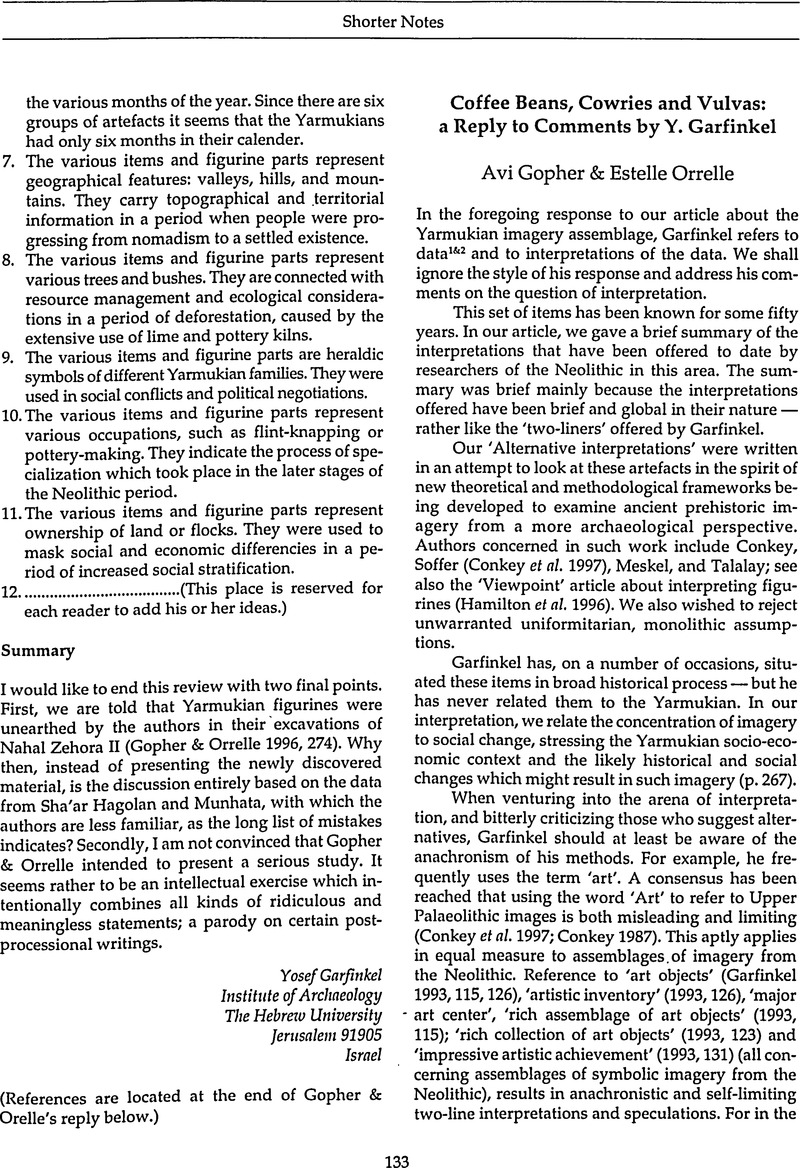No CrossRef data available.
Article contents
Coffee Beans, Cowries and Vulvas: a Reply to Comments by Y. Garfinkel
Published online by Cambridge University Press: 14 October 2009
Abstract
An abstract is not available for this content so a preview has been provided. Please use the Get access link above for information on how to access this content.

- Type
- Shorter Notes
- Information
- Copyright
- Copyright © The McDonald Institute for Archaeological Research 1999
References
Conkey, M.W., 1987. New approaches in the search for meaning? A review of research in Palaeolithic art. Journal of Field Archaeology 14, 413–30.Google Scholar
Conkey, M.W., Soffer, O., Stratmann, D. & Jablonski, N.G. (eds.), 1997. Beyond Art: Pleistocene Image and Symbol. (Wattis Symposium Series in Anthropology, Memoirs of the California Academy of Sciences 23.) San Francisco (CA): California Academy of Sciences.Google Scholar
Garfinkel, Y., 1992a. The Material Culture in the Central Jordan Valley in the Pottery Neolithic and Early Chalcolithic Periods. Unpublished Ph.D. Dissertation, The Hebrew University, Jerusalem.Google Scholar
Garfinkel, Y., 1992b. The Pottery Assemblages of Sha'ar Hagolan and Rabah Stages from Munhata (Israel). (Les cahiers du centre de recherche français de Jerusalem 6.) Paris: Association Paléorient.Google Scholar
Garfinkel, Y., 1993. The Yarmukian culture in Israel. Paleorient 19(1), 115–34.CrossRefGoogle Scholar
Garfinkel, Y., 1995. Human and Animal Figurines of Munhata (Israel). (Les Cahiers des missions archéologiques françaises den Israel 8.) Paris: Association Paléorient.Google Scholar
Gopher, A., 1995. Early pottery-bearing groups in Israel: the pottery Neolithic period, in The Archaeology of Society in the Holy Land, ed. Levy, T.. London: Leicester University Press, 205–25.Google Scholar
Gopher, A. & Orrelle, E., 1995. The Ground Stone Assemblages of Munhata. (Les cahiers du centre de recherche francais de Jerusalem 7.) Paris: Association Paléorient.Google Scholar
Gopher, A. & Orrelle, E., 1996. An alternative interpretation for the material imagery of the Yarmukian, a Neolithic culture of the sixth millennium BC in the Southern Levant. Cambridge Archaeological Journal 6(2), 255–79.CrossRefGoogle Scholar
Hamilton, N., Marcus, J., Bailey, D., Haaland, G., Haaland, R. & Ucko, P.J., 1996. Viewpoint: can we interpret figurines? Cambridge Archaeological Journal 6(2), 281–307.Google Scholar
Karageorghis, V., 1986. Kypriaka IX. Report of the Department of Antiquities of Cyprus, 45–7.Google Scholar
Morphy, H., 1991. Ancestral Connections Art and an Aboriginal System of Knowledge. Chicago (IL): The University of Chicago Press.Google Scholar
Noy, T., 1968. Fertility figurines of the Neolithic period. The Israel Museum News 3, 51–4.Google Scholar
Officer, K.L.C., 1991. What's in an anthropomorph?, in Rock Art and Prehistory: Papers Presented to Symposium G of the AURA Congress, Darwin 1988, eds. Bahn, P. & Rosenfeld, A.. (Oxbow Monograph 10.) Oxford: Oxbow Books, 112–19.Google Scholar
Perrot, J., 1965. IV Campagne de fouilles a Munhata. Academie des Inscriptions et Belles-lettres, 407–11.CrossRefGoogle Scholar
Stekelis, M., 1972. The Yarmukian Culture of the Neolithic Period. Jerusalem: The Magnes Press.Google Scholar
Yeivin, E. & Mozel, I., 1977. A fossil directeur figurine of the Pottery Neolithic A. Tel Aviv 4, 194–200.CrossRefGoogle Scholar


